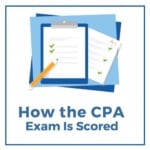The Business Environment and Concepts (BEC) test is one of four CPA exam sections (along with AUD, FAR, and REG). This test covers many practical areas of business that you’ll use as a manager or company owner. Furthermore, many of these topics and economic concepts are covered in undergraduate business and economics courses. Consequently, it makes sense that this is the easiest section of the exam to pass based on the AICPA’s recorded pass rates.
However, you don’t want to take it easy just yet. This guide explains the format of the BEC test, important tips that will help you answer a large number of questions, and provides some guidance on creating a study plan.
If you’re studying for the BEC test and starting to feel overwhelmed, read on!
See the Top CPA Review Courses
- 1. Becker CPA Review Course ◄◄ Endorsed by Big 4 Accounting Firms + Save $1,330
- 2. Surgent CPA Prep Course ◄◄ Best Adaptive Technology
- 3. Gleim CPA Study Materials ◄◄ Largest CPA Test Bank
BEC CPA Exam Format
The CPA Exam includes four tests. Essentially, candidates have four hours to take each CPA exam section, including BEC.
As the AICPA explains: “Each of the four Exam sections is broken down into five smaller sections called testlets. These testlets feature multiple-choice questions (MCQs) and task-based simulations (TBSs). You will receive at least one research question (research-oriented TBS) in the AUD, FAR and REG sections.”
While the BEC test does not include research-oriented questions, it does include written communication tasks. The AICPA also points out that “Written communication tasks appear only in the BEC section of the CPA Exam. For each of three written communication tasks, you must read a scenario and then write an appropriate document relating to the scenario. The instructions state what form the document should take (such as a memo or letter) and its focus. Your response should provide the correct information in writing that is clear, complete and professional.”
To succeed on the BEC written communication tasks, use general best practices for writing any informative piece. Essentially, your approach should include an outline and a clear thought pattern that the reader can follow.
BEC CPA Exam Fees
The cost to take the CPA exam varies by state. Typically, this fee is between $50 and $200. Additionally, many candidates purchase CPA review courses, which may cost from $1,000 to $2,500. Technically, this isn’t a direct exam fee. However, the necessity of additional practice questions and other review materials for earning a passing exam score means that most students taking the CPA BEC exam should account for these costs in their budgeting.
Once you understand how the BEC test format works and you pay your fees, review the frequently tested BEC topics.
Learn More About The CPA Exam
- How To Become A CPA
- CPA Exam Stats and Facts
- Best Order To Take CPA Exam
- Motivational Songs For Studying
BEC CPA Exam Questions
Here are four topics that you’ll see on every BEC test. Use these tips to successfully answer questions on these topics:
1. Business cycle questions
The BEC test includes questions on economic topics. Consequently, these concepts can be challenging, if you haven’t taken an economic course recently or have limited experience with financial statements.
The business cycle is one economic topic that is on every BEC test. As a financial management professional or business owner, you need to understand the phases of the business cycle and how they impact the economy. Essentially, the cycle is determined using gross domestic product (GDP), which measures total US economic output.
Your BEC test will ask you to identify each of the four phases of the cycle. Additionally, you must know the phases in the correct order. While the length of time of each cycle can vary, the phases do occur in a predictable order:
- Peak: After a period of economic expansion, the economy reaches a peak of economic activity and then transitions into a contraction.
- Contraction: The economy is shrinking in this phase. Typically, GDP growth may slow to a growth rate of zero or even negative growth. Toward the end of this phase, unemployment will start to increase because fewer jobs are needed.
- Trough: The economy “hits bottom” in this phase, then the economy moves into an expansion phase.
- Expansion: GDP grows during the expansion phase. At the end of this phase, the economy may start to “overheat”, which means that growth and inflation are both growing at a relatively fast rate.
You’ll definitely see questions on this important economic topic, so get informed!
2. Policies that impact the economy
To answer questions on the economic portion of the BEC test, you need to understand how certain entities impact economic activity.
For example, the federal government uses fiscal policy to impact the economy. This policy may include tax cuts, increased government spending, or both.
The US central bank, on the other hand, uses monetary policy to impact the economy via the Federal Reserve System (FED). The FED manages the supply of money available in the economy and the money supply affects interest rates.
Assume, for example, that the FED reduces the amount of money in the economy by selling government bonds. As the FED sells bonds, investors exchange money for bonds and the supply of money in the economy declines. Consequently, these actions force interest rates up and higher interest rates typically slows the economy.
Ultimately, you need to study both fiscal and monetary policy and how each type of policy impacts economic activity.
3. Cost accounting topics
Cost accounting may be the most difficult area of accounting because the language differs from financial accounting, managerial accounting, and other topics. However, the BEC test covers a number of cost accounting topics, so this is information that you need to know!
Every BEC test asks questions about four types of costs: direct costs, indirect (overhead) costs, period costs, and product costs. To understand these concepts, think of these terms in pairs.
First, consider direct and indirect costs. Direct costs can be directly traced to a product or service. If you manufacture baseball gloves, for example, the leather material used and the labor costs incurred to make the gloves are direct costs.
Alternatively, indirect costs cannot be directly traced to a product. Instead, these costs must be allocated based on an activity level. The baseball manufacturer, for example, incurs utility costs to heat and cool the factory. Those costs can be allocated to each baseball glove using direct labor hours incurred, or some other activity level.
Next, think about period vs. product costs as a second pair of terms. Period costs, such as insurance premiums and interest expenses, are incurred due to the passage of time. Product costs include material and labor costs that can be directly traced to production.
Make sure that you’re crystal clear about these four terms.
4. Foreign currency BEC exam questions
This may be the most difficult concept on the CPA exam. Unfortunately, you’ll see some questions related to this topic on BEC. Truthfully, many students skip these difficult questions. However, you can use this discussion to answer foreign currency questions and conquer this specific MCQ testlet!
Here’s a simplified example: assume that Standard Bikes is a US-based bike manufacturer that sells bikes in France, which uses the Euro. The current exchange rate is $1 US to .70 Euro. Hence, if Standard sells a bike for 700 Euros, they can be converted into 1,000 US dollars.
When you get a currency question, create a simple example like this so that you can understand how the current exchange rate impacts the money received or paid.
Get Discounts On CPA Review Courses!
CPA BEC Practice Exams
Before you start working practice exams, take a look at the most current AICPA Blueprint for the BEC test. This document lists the percentage of test questions for each topic.
After you work a practice exam and review your incorrect answers, refer to the Blueprint. If you missed a number of questions on a topic that is heavily tested, invest more time to review that particular concept.
This strategy will help you use your study time effectively, and focuses your efforts on the most-tested material. Here are some more tips that can save you time and help you get the most out of your study materials!
Create a study plan
Estimates vary, but most CPA exam candidates spend 300-400 hours to study for and pass the CPA exam. To make the most of your available time, create a written plan.
Putting a plan in writing forces you to consider other time commitments, such as your work schedule, personal commitments, holidays, etc. Create a plan to set up a reasonable amount of time to study for each test.
Use the AICPA practice exams
Most CPA candidates purchase study materials that offer practice exams, but don’t forget that the AICPA offers some free sample tests. Use this free resource.
Stick to Your Plan
Passing the BEC test requires a huge time commitment, and the process can feel overwhelming. Use the tips listed here to study effectively and to pass the BEC test!
COMPARE THE BEST CPA REVIEW COURSES
Frequently Asked Questions about BEC CPA
Is BEC the easiest CPA exam?
When looking at the CPA exam pass rates for the different sections of the CPA exam, BEC has the highest in all four quarters of the year. This implies that it’s the easiest section to pass— but it doesn’t mean you shouldn’t prepare for the test!
How many hours should you study for BEC CPA?
It’s recommended that you devote between 300 and 400 hours studying for all four sections of the CPA exam. How you divide that time is up to you; however, most students believe that BEC is the easiest section to pass, so you may only need to devote between 50 and 75 of these hours on studying for it.
How do I study for the BEC CPA exam?
To study for the Business Environment and Concepts section of the CPA exam, look for study materials that cover relevant topics such as financial management, corporate governance, and professional communication. You can find specific lectures and practice materials on these subjects when you sign up for a well-made CPA exam review course.
Can you study for BEC in 2 weeks?
Theoretically, it’s possible for you to prepare for the BEC in a 2 week period— after all, it’s one of the easiest sections to pass and can be prepared for in less than 100 hours. However, you’re going to want to devote as much time as possible toward your study efforts during those two weeks: no distractions!








